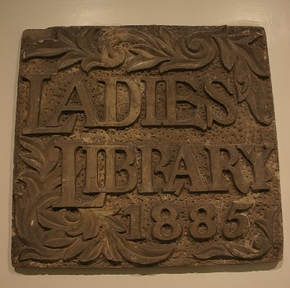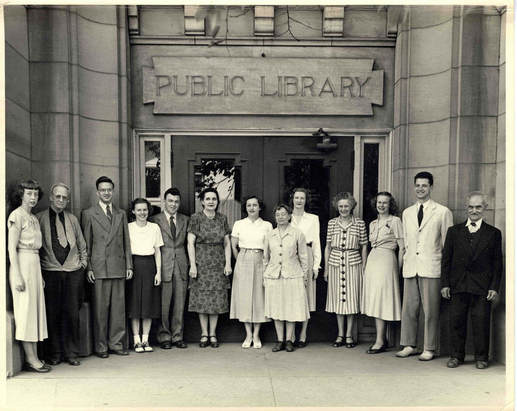The LLA was formed in 1866 when 35 women in Ann Arbor got together to form a small lending library, based on the Benjamin Franklin model of subscription, in a space that they rented above Main Street. (A great number of now public community libraries in the United States were started by ladies associations just like this one. Anne Firor Scott in her article “Women and Libraries,” published in the Spring 1986 volume of The Journal of Library History estimates as many as 75%.) Each woman agreed to give $3 initially plus another $1 each year toward the purchase of new books (or donating books themselves in lieu of the yearly dues) in support of the new library.
The library grew rapidly with nearly 900 books by the end of its first year, when it was forced to move to a larger location. Having enough space proved to be a recurring problem, and they moved several times to successively larger accommodations (including, at one point, the top level of the Court House) until, in 1885, the LLA had their first building erected at 324 East Huron Street in the Romanesque revival style (sadly, it was torn down in 1946). Thanks to rigorous fundraising, the building was paid off by 1892.
It was designed by famed architect and local boy Irving K. Pond, a University of Michigan graduate and a partner with his brother in the same Chicago-based firm that designed the Michigan Union and the Michigan League buildings. (The Pond brothers were also the architects for Chicago’s celebrated Hull House.) Pond’s mother, Mary, was a founding member of the LLA, and his father, Elihu, was an editor at the Argus, one of Ann Arbor’s more successful newspapers of the 19th century and a strong supporter of the library.
Start here if you’re continuing this article from the September newsletter…
Before the new building, however, the LLA proposed in 1870 to the city council that their subscription library be taken over by the city to form a free public library. This was rejected. In 1879, it was proposed that the LLA library be combined with the that of the Ann Arbor Board of Education. This proposal was rejected by the LLA, thus the purchase of land in 1880 and the 1885 building by Pond.
The LLA did more than lend books, hosting several guest speakers, a series of social readings, art receptions, musical performances, and held various fundraisers. Often reporting on the LLA’s events and special announcements, the newspapers of the time seemed quite enamored and impressed with the LLA in their coverage of the library. The March 3rd, 1876 edition of the Michigan Argus includes a report on a “dramatic entertainment given by the Garrick Club… for the benefit of the [LLA]” that netted them about $90. Two days later, the LLA published its thanks in the Argus, to everyone involved in the celebration of its 10th anniversary party, which included “so attractive an art gallery.”
The public also showed much support. On June 10th, 1885 the Ann Arbor Courier reported that “several offers of assistance have been reported to the [LLA] board” in response to the announcement of the intended dedicated library building. “One gentleman promises to do the gas fitting, another contributed $25.00 toward the gas, and another will give the insurance of the building for three years.” The Courier reported other cash donations and that one LLA member offered her services as librarian for the first year, which saved the LLA over $50.
It wasn’t until 1902 that then-president of the LLA, Anna Botsford Bach, suggested applying for a grant from Andrew Carnegie to build a public city library. A philanthropist and booklover as well as a wildly successful businessman, Carnegie had a personal relationship with libraries (his father helped found a Tradesman’s Subscription Library), and he credited use of libraries with giving regular workers (himself included) a leg up in improving themselves and their stations. Thousands of libraries were built all across the globe with Carnegie grants.
The Ann Arbor School Board and city council joined the LLA in supporting the application. They were granted $20,000 in 1903, but the three co-applicants argued over a site for the new building. The School Board naturally preferred the library to be close to the high school for the convenience of its students, while the LLA thought that a separate location would better suit the public’s needs. In 1904, the School Board and city council re-submitted the application to Carnegie without the LLA and were granted $30,000.
After the high school burned down in 1904, it was decided that the new high school (completed in 1907) would have a wing devoted to the new library. The LLA was invited by the Board of Education to join, and they accepted. In 1908, the LLA donated its collection of approximately 4,600 books to the public school district library. In 1916, the Huron Street property was deeded to the Board of Education and was used, variously, as the Krusczka School of Dancing and headquarters for the Boy Scouts. It was then sold in 1944 to the Michigan Bell Telephone Company, who tore it down to make way for their new office building.
1957 saw the dedication of the new Ann Arbor Public Library building (designed by architect Alden B. Dow), which still stands today at the corner of 5th Avenue and Williams Street in downtown Ann Arbor, though it has more than doubled in size since. As part of the centennial celebration of the LLA, the cornerstone from the 20-years gone 1885 building was installed at the 5th Avenue Public Library location. And today, that very same cornerstone can be found in the stairwell between the old and the new parts of the downtown branch of the (renamed) Ann Arbor District Library, now five branches strong.
—Crysta Coburn


